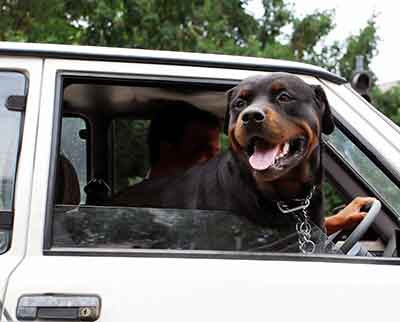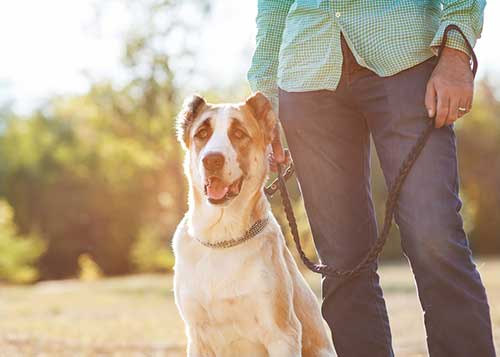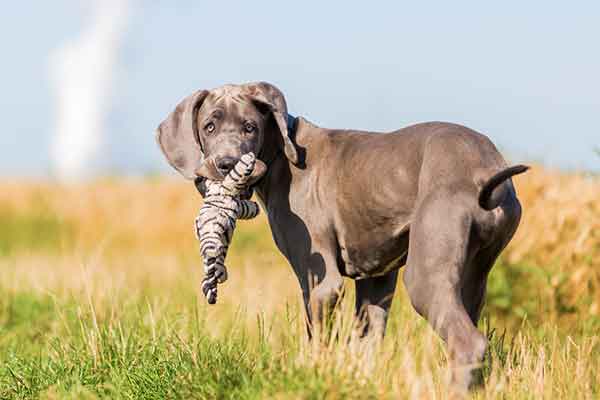From their black, round, beady eyes and floppy, velvet-like ears to their uncoordinated, oversized paws and disproportionate, large head – nothing is cuter than a giant-breed puppy.
Like the titular character in Walt Disney’s animated classic ‘Dumbo,’ you can’t help but smile as your new family member struggles to get to grips with the world they’ve been born into.
As they get better at navigating their surroundings, you’ll start looking forward to the moments when you can walk them around the neighbourhood nicely on a leash or take them in the car with you, their bear-like head hanging out of the crack in the window and big tongue lolling everywhere as passers-by point, wave, and smile at them.
However, as cute as your new furry friend might be, it’s essential that you start teaching them boundaries immediately to avoid the risk of any behavioural challenges when they get bigger.
A well-trained, gentle giant will keep everyone at home (and outside!) happy, and by using the correct training methods, you, as their owner, can have fun while helping them adopt the necessary skills.
Yet, knowing where to start can be difficult if you’re a first-time giant-breed owner; therefore, we’ve created this article outlining some of our top training tips for giant puppies.
From rewarding good behaviour and investing in dog insurance, whether you’ve got an English Mastiff, Newfoundland, St. Bernard, or other popular giant breeds, you’ll be able to make use of the tips below:
Teach Basic Commands First
Three of the most important words you will ever teach your giant-breed puppy are stay, sit, and come; therefore, you should begin immediately. When your dog weighs as much as a small child (or in some cases more!), these three basic commands are vital for ensuring your family’s safety and others around you.
Ownership of a giant-breed dog comes with much responsibility, not to mention many negative connotations of the breed, which are largely untrue. However, it is still essential to be wary. For instance, if a toy breed like a Pomeranian or Chihuahua jumps up excitedly at passers-by who stop to pet them, it is considered cute and harmless.
On the other hand, if a giant breed like a Cane Corso or Mastiff were to do the same, it could be viewed as frighting or dangerous (no matter how pure their intentions!) and highlight inadequate training on the owner’s behalf. Therefore, it is essential to ingrain the three basic commands of sit, stay, and come into your giant-breed puppy from an early age to avoid future problems and ensure they’re well-behaved.
Train Your Giant-Breed To Travel In The Car
If you want to take your pooch to new places, your car will be your best friend. Yet, it is essential that you teach your giant breed puppy how to travel in the car to ensure they feel confident and calm no matter where your travels may take you both.
Failure to teach proper car etiquette to your giant breed can lead to stress, anxiety, and even a visit to the vet – which we’re sure you didn’t have in mind when you said you wanted to travel with your pooch!

There are several steps to follow to ensure that your car and your giant-breed puppy become the best of friends; some of them are as follows:
1. Gradually get your dog used to the car by rewarding them with a treat whenever they are calm around or inside it. You could keep an item of yours with them while they travel so your scent can calm them.
2. When travelling with your dog, always ensure that they are restrained – it’s the law in the UK!
3. Start with short journeys first so your dog can get used to the sensations and sights associated with travel.
4. Practice letting them in and out of the car safely.
5. Start by having a close friend or partner in the cabin with your dog so they can feel comforted by their presence.
The previous steps can make car training your giant-breed puppy more straightforward. However, if you start noticing your dog behaving strangely or symptoms such as excessive drooling, panting, excessive swallowing, retching, trembling or restlessness or vomiting while riding in the car, ensure that you never force them to ride in the car.
If this occurs frequently, it would be best to seek the advice of a veterinary professional, which you can get around the clock from dog insurance providers like Purely Pets. From twenty-four-seven complimentary video calls with a vet to an easy online claims process, their range of policies can give you peace of mind and ensure that your giant-breed dog remains happy from puppyhood to adulthood. Consider visiting their website to find out more, or contact them directly for further inquiries.
Instil Polite Leash Walking Into Your Puppy
One of the most challenging aspects of training a giant-breed puppy is leash training. Since giant breeds require much daily exercise, it is essential that you start leash training as early as you can so that you don’t run the risk of your dog walking you as they get bigger.
While your puppy is in the early stages of leash training, it is wise to equip them with a short, nonretractable leash and a harness to make walking with a leash more comfortable for your pup and to give you more control!
As you progress on your route, you should motivate them with treats or use a click trainer, which is also helpful for other obedience-related training tasks! Although these tools can help to encourage them on walks, what will help them is sticking to a routine, as this will help them predict events and stop them from feeling anxious, stressed or any other negative emotions.
The critical takeaway is to start leash training as soon as possible and practise, as the sooner you instil polite leash walking into your giant breed, the sooner they can accompany you everywhere. Failure to do so could make you feel uneasy about taking your pup out and increase the risk of them getting themselves (and you!) into trouble.

Prevent Counter Surfing And Food Theft
No matter the age of your giant breed, nothing is cuter than seeing those beady, black eyes staring back at you. It can get even harder to resist when it comes to mealtimes, and those beady, black eyes somehow become as wide as saucers (literally!), especially when you’ve got a piece of juicy steak hanging from the tip of your fork.
Unless you’re completely heartless, we’ve all slipped our puppy a slither of human food here and there, which is fine occasionally. However, if you’re giving them something off your plate every mealtime, then a treat becomes an expected behaviour. Therefore, you should do your best to prevent counter surfing, food theft, and begging from a young age.
As your giant-breed puppy grows, you’ll likely notice that its size makes reaching the countertop and dining table much more accessible than a traditional-sized dog can. Due to this, anything edible within your giant puppy’s snout is available to be turned into leftovers. To avoid your Sunday roast being turned into the dog’s dinner, it is essential that you teach the command ‘leave it’ from puppyhood long before they can reach those surfaces.
Fortunately, there are various ways to encourage your dog to be less food conscious, from wiping down surfaces thoroughly, never keeping food on counters, keeping your dog out of the room while food is being prepared and more. Yet, no matter how well-trained your dog is, you should avoid leaving them alone with unsupervised food, as one day, the temptation may prove too great! Therefore, training is a safety blanket if you must leave food alone.
Don’t Be Scared To Approach A Professional
Training a giant-breed puppy is much more challenging than teaching a normal-sized dog, and there is no shame if you discover that it’s much more arduous than you might’ve thought. If this is the case, and you find yourself struggling to keep your giant-breed puppy under control, don’t be scared to approach a professional.
A professional dog trainer can help teach your dog (and you!) various skills and techniques you can use to teach your dog positive reinforcement so that they can handle a variety of situations and help you bond better with your furry friend. For as little as £20 per hour, you can help start your giant-breed puppy off on the right foot (or paw, rather?) with accredited tools and communication skills.
Depending on the kind of dog trainer you approach, some may even offer group puppy training classes, which is an excellent way to get your dog accustomed to other dogs and gives you a chance to meet like-minded individuals whom you can meet up with outside of class for dog walks, share training-related advice, ask for recommendations and much more.
Or, if group classes don’t sound like your thing, your trainer might be able to offer one-to-one courses from the comfort of your own home or virtual ones using a video-sharing platform like Zoom, Skype or Microsoft Teams.

